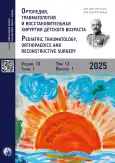Surgical treatment of severe pectus excavatum in an adolescent: a case report
- Authors: Ryzhikov D.V.1, Dolgiev B.H.1, Vissarionov S.V.1, Zhukova J.O.1, Boroznyak I.A.2
-
Affiliations:
- H. Turner National Medical Research Center for Сhildren’s Orthopedics and Trauma Surgery
- Kursk Regional Children’s Clinical Hospital
- Issue: Vol 13, No 1 (2025)
- Pages: 77-85
- Section: Clinical cases
- URL: https://bakhtiniada.ru/turner/article/view/312545
- DOI: https://doi.org/10.17816/PTORS654520
- EDN: https://elibrary.ru/BXDWFN
- ID: 312545
Cite item
Abstract
BACKGROUND: Pectus excavatum is a malformation characterized by deformities of the cartilaginous parts of the ribs and sternum of varying severity and accounts for 75%–91% of all chest wall deformities. Surgical treatment of pectus excavatum in children remains an urgent issue, despite the considerable number of existing surgical correction techniques. These techniques are not universally applicable, especially for asymmetric and rigid forms, requiring ongoing modification and improvement.
CASE DESCRIPTION: A 17-year-old patient underwent surgical correction of a severe pectus excavatum complicated by a history of cardiac surgery, namely, median sternotomy and mitral valve prosthesis placement. The surgical procedure involved the release of major vital anatomical structures, the use of an external fixation device providing high corrective force during surgery, and gradual intraoperative correction under cardiac function monitoring.
DISCUSSION: Correction of severe pectus excavatum following prior median sternotomy is associated with a high risk of complications, including fatal events such as asystole or massive hemorrhage. In such cases, a minimally invasive thoracoplasty with an additional subxiphoid approach and sternal elevation using an external fixation device is recommended. Conventional sternal elevation techniques (e.g., bone hooks, sutures, and clamps) have been found to be not advisable for pronounced rigid deformities owing to the risk of sternal injury. Moreover, isolated thoracoscopy using the standard MIRPE technique does not ensure the integrity of intrathoracic structures, and traditional bar-flipping maneuver for immediate and forced correction of pectus excavatum is inappropriate.
CONCLUSION: Patients with pectus excavatum exceeding the threshold for severe deformity, particularly those with previous cardiac surgery, require a treatment different from standard thoracoplasty. The presented approach, involving the release of major vital anatomical structures and gradual intraoperative correction under cardiac monitoring with an external fixation device, is recommended for managing such complex clinical cases.
Full Text
##article.viewOnOriginalSite##About the authors
Dmitry V. Ryzhikov
H. Turner National Medical Research Center for Сhildren’s Orthopedics and Trauma Surgery
Author for correspondence.
Email: dryjikov@yahoo.com
ORCID iD: 0000-0002-7824-7412
SPIN-code: 7983-4270
MD, PhD, Cand. Sci. (Medicine)
Russian Federation, Saint PetersburgBahauddin H. Dolgiev
H. Turner National Medical Research Center for Сhildren’s Orthopedics and Trauma Surgery
Email: dr-b@bk.ru
ORCID iD: 0000-0003-2184-5304
SPIN-code: 2348-4418
MD
Russian Federation, Saint PetersburgSergei V. Vissarionov
H. Turner National Medical Research Center for Сhildren’s Orthopedics and Trauma Surgery
Email: vissarionovs@gmail.com
ORCID iD: 0000-0003-4235-5048
SPIN-code: 7125-4930
MD, PhD, Dr. Sci. (Medicine), Professor, Corresponding Member of RAS
Russian Federation, Saint PetersburgJulia O. Zhukova
H. Turner National Medical Research Center for Сhildren’s Orthopedics and Trauma Surgery
Email: julsapzhuk@yandex.ru
ORCID iD: 0009-0009-8862-1330
MD
Russian Federation, Saint PetersburgIrina A. Boroznyak
Kursk Regional Children’s Clinical Hospital
Email: irishka25121998@mail.ru
ORCID iD: 0009-0002-8074-7798
MD
Russian Federation, KurskReferences
- Suehs CM, Molinari N, Bourdin A, et al. Change in cardiorespiratory parameters following surgical correction of pectus excavatum: protocol for the historical-prospective HeartSoar cohort. BMJ Open. 2023;13(6):e070891. EDN: ZIOZHW doi: 10.1136/bmjopen-2022-070891
- Ciriaco P. Surgical treatment of pectus excavatum: the boundary between pathologic and aesthetic need. J Clin Med. 2025;14(1):231. doi: 10.3390/jcm14010231
- Higaze M, Haj Khalaf MA, Parjiea C, et al. Minimally invasive repair of pectus excavatum: a lifeline to quality of life. J Clin Med. 2024; 13(22):68–88. EDN: ECFUFD doi: 10.3390/jcm13226888
- Hebra A, Kelly RE, Ferro MM, et al. Life-threatening complications and mortality of minimally invasive pectus surgery. J Pediatr Surg. 2018;53(4):728–732. doi: 10.1016/j.jpedsurg.2017.07.020
- Beati F, Frediani S, Pardi V, et al. Case report-Every thoracic surgeon’s nightmare: cardiac and lung perforation during placement of Nuss bar for pectus excavatum. Front Pediatr. 2023;11:1241–1273. EDN: TXMZVF doi: 10.3389/fped.2023.1241273
- Media AS, Christensen TD, Katballe N, et al. Complication rates rise with age and Haller index in minimally invasive correction of pectus excavatum: a high-volume, single-center retrospective cohort study. J Thorac Cardiovasc Surg. 2024;168(3):699–711. EDN: YPCYWG doi: 10.1016/j.jtcvs.2024.01.047
- Dolgiev BH, Ryzhikov DV, Vissarionov SV. Surgical treatment of children with asymmetric pectus excavatum: literature review. Pediatric Traumatology, Orthopaedics and Reconstructive Surgery. 2022;10(4):471–479. EDN: VCVCLZ doi: 10.17816/PTORS112043
- Torre M, Guerriero V, Wong MCY, et al. Complications and trends in minimally invasive repair of pectus excavatum: a large volume, single institution experience. J Pediatr Surg. 2021;56(10):1846–1851. EDN: WZSVSN doi: 10.1016/j.jpedsurg.2020.11.027
- Park HJ, Lee IS, Kim KT. Extreme eccentric canal type pectus excavatum: morphological study and repair techniques. Eur J Cardiothorac Surg. 2008;34(1):150–154. doi: 10.1016/j.ejcts.2008.03.044
- Cujiño-Álvarez IF, Torres-Salazar D, Velásquez-Galvis M. Cardiorespiratory arrest during and after nuss procedure: case report. J Cardiothorac Surg. 2023;18(1):166. EDN: DZEOTZ doi: 10.1186/s13019-023-02262-w
- Kenney LM, Obermeyer RJ. Pectus repair after prior sternotomy: clinical practice review and practice recommendations based on a 2,200-patient database. J Thorac Dis. 2023;15(7):4114–4119. EDN: PKJTVC doi: 10.21037/jtd-22-1567
- Jaroszewski DE, Gustin PJ, Haecker FM, et al. Pectus excavatum repair after sternotomy: the Chest Wall International Group experience with substernal Nuss bars. Eur J Cardiothorac Surg. 2017;52(4):710–717. doi: 10.1093/ejcts/ezx221
Supplementary files













